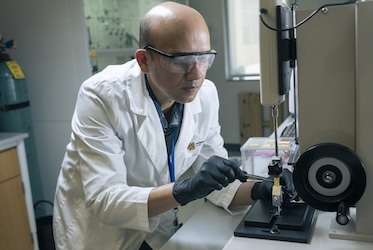
Kennesaw State professor shows switchgrass can clean contaminated soil
KENNESAW, Ga. | Mar 18, 2022
A Kennesaw State University researcher in the College of Science and Mathematics has an economical and ecologically sound method for cleaning contaminated soil and
reducing its harmful effects: Grow some grass.

Associate professor of biology Sigurdur Greipsson recently finished four years of research under a $160,453 grant from the National Science Foundation (NSF) that showed planting switchgrass, a tall perennial grass native to North America, can reduce lead contamination in soil.
The study, which measured lead levels at three sites in Georgia, including a former Superfund site near Cedartown and a pair of much-cleaner sites in the Atlanta area, has implications for several industries that rely on restoration of soil, including agriculture, healthcare and real estate.
“Clearly, cleaner soil is better for growing crops, and in the future, there will be more demand for agricultural soil to be clean and certified for production,” Greipsson said. “Our research has shown that switchgrass can help with that.”
According to Greipsson, reducing lead exposure from contaminated soil could also reduce healthcare costs for people living and playing on formerly contaminated land.
“Removing lead and other contaminants could make a piece of previously polluted land suitable for development and possibly improve nearby property values,” he said.
Additionally, agriculture on previously polluted land can also contribute to cleaner energy and reducing the pace of climate change, Greipsson said. His research showed that the nitrogen switchgrass adds to previously contaminated soil can aid the cultivation of crops like corn or soybeans, which are used to make biofuels that can contribute to ethanol production in the United States.
“This is a simple, inexpensive solution to contaminated soil that can be deployed throughout the South, because switchgrass grows well in humid climates,” Greipsson said.

Greipsson said switchgrass grows without the help of fertilizer. The growth of switchgrass also plays to the renewed interest in “rewilding” certain areas — giving plots of formerly contaminated land back over to naturally occurring plants like switchgrass.
Greipsson has taught at Kennesaw State since 2008, focusing on general biology and restoration ecology, the umbrella under which his recent work falls. He has studied phytoextraction for more than 30 years and said the work will continue as people seek cleaner soils and greener spaces for habitation, recreation and agriculture.
– Dave Shelles
Photos by Jason Getz
Related Stories

Passions spark innovation at Kennesaw State Symposium of Student Scholars

Kennesaw State researcher tackling sustainability through use of transparent wood

Kennesaw State students to present research at Symposium of Student Scholars

Chemistry student engaged in sustainable catalyst research through Kennesaw State's First-Year Scholars program
A leader in innovative teaching and learning, Kennesaw State University offers undergraduate, graduate, and doctoral degrees to its more than 47,000 students. Kennesaw State is a member of the University System of Georgia with 11 academic colleges. The university’s vibrant campus culture, diverse population, strong global ties, and entrepreneurial spirit draw students from throughout the country and the world. Kennesaw State is a Carnegie-designated doctoral research institution (R2), placing it among an elite group of only 8 percent of U.S. colleges and universities with an R1 or R2 status. For more information, visit kennesaw.edu.















